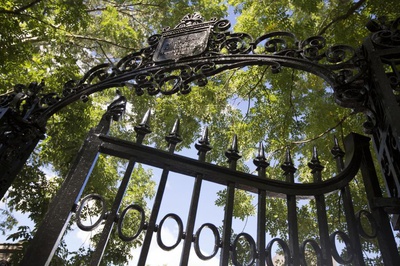
News
Harvard Researchers Develop AI-Driven Framework To Study Social Interactions, A Step Forward for Autism Research

News
Harvard Innovation Labs Announces 25 President’s Innovation Challenge Finalists

News
Graduate Student Council To Vote on Meeting Attendance Policy

News
Pop Hits and Politics: At Yardfest, Students Dance to Bedingfield and a Student Band Condemns Trump

News
Billionaire Investor Gerald Chan Under Scrutiny for Neglect of Historic Harvard Square Theater
Harvard Researchers Confirm First Earth-Sized Exoplanet in Habitable Zone

Researchers at Harvard, MIT, and other institutions used a new telescope to confirm the existence of the first Earth-sized planet outside our solar system in a habitable zone, a step toward understanding how life formed on Earth and could form in other solar systems.
The study, published in the Astronomical Journal on Aug. 14, used NASA’s Spitzer telescope to confirm the observations of the exoplanet, known as TOI-700 d, orbiting the star TOI-700. Researchers had also previously observed the exoplanet with NASA’s Transiting Exoplanet Survey Satellite space telescope.
An exoplanet is any planet outside of our solar system. The exoplanet researchers identified — TOI-700 d — is considered to be within a habitable zone because its position relative to the TOI-700 star and its temperature suggest it could have liquid water on its surface.
Joseph E. Rodriguez — the study’s lead author who is affiliated with the Harvard-Smithsonian Center for Astrophysics — said TESS’s observations of nearby stars allowed them to characterize TOI-700 d as habitable relatively easily.
“The unique and really exciting aspect about TESS is that it's looking at the closest stars to us. So they're much, much brighter, we can really do a lot more characterization by observation,” Rodriguez said. “Of all the previously known systems that were Earth-sized and in the habitable zone or close to it, this was by far the brightest one, and therefore it's the most amenable.”
Emily A. Gilbert, a graduate student at the University of Chicago who led one of three studies about the exoplanet’s solar system, said scientists believe the exoplanet has Earth-like characteristics and could have life.
“The temperature would be pretty similar, given a couple different variables, and it's small enough that we think the planet could be rocky,” Gilbert said.
Still, she conceded that its conditions are “definitely not the exact same conditions as Earth for producing life.”
“But we don't know how life got here on Earth, so we're trying to figure it out as we go along,” Gilbert added.
Another feature of TESS that enabled the discovery is the large span of the sky that it surveyed. Many of its observed exoplanets are closer to Earth than those other telescopes have observed.
“This star is at 31 parsecs, so that’s about 100 light years away,” said Jennifer G. Winters, a researcher at the Harvard-Smithsonian Center for Astrophysics who helped observe the TOI-700 star for Gilbert’s study. “We consider that to be a nearby star.”
Despite TOI-700 d’s relative closeness to Earth compared to other exoplanets scientists are currently studying, Rodriguez said traveling to this exoplanet remains impossible with current technology.
“It would take us 100,000 years to travel there given the current technology,” he said. “So the actual visitation and seeing these things in real life are not in the realm of possibility.”
Although scientists confirmed the exoplanet’s approximate size and potential for liquid water, they have yet to confirm any additional features — such as composition or mass — to suggest it could contain life forms.
“Is the planet actually Earth-like? I think that’s the biggest question,” Rodriguez said.
He believes the discovery of TOI-700 d could have major implications about extraterrestrial life and the formation of life on Earth — a topic of perennial public interest.
“I think there’s something very relatable about exoplanets, or planets in general, and the general public, because we all want to know that golden question about life. Is there life elsewhere? How did life form?” Rodriguez said. “We’re just starting to chip away at this major question from a different angle.”
Want to keep up with breaking news? Subscribe to our email newsletter.
From Our Advertisers

Over 300+ courses at prestigious colleges and universities in the US and UK are at your disposal.

Where you should have gotten your protein since 1998.

Serve as a proctor for Harvard Summer School (HSS) students, either in the Secondary School Program (SSP), General Program (GP), or Pre-College Program.

With an increasingly competitive Law School admissions process, it's important to understand what makes an applicant stand out.

Welcome to your one-stop gifting destination for men and women—it's like your neighborhood holiday shop, but way cooler.

HUSL seeks to create and empower a community of students who are seeking pathways into the Sports Business Industry.
